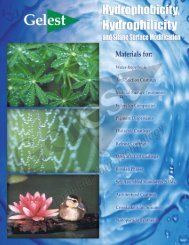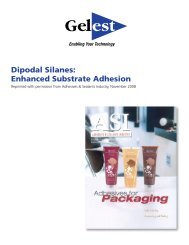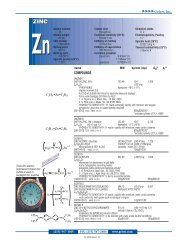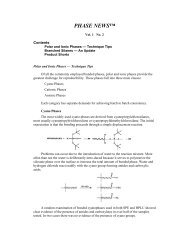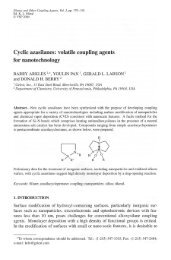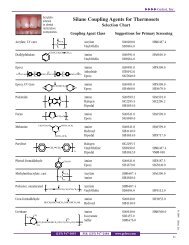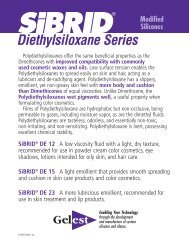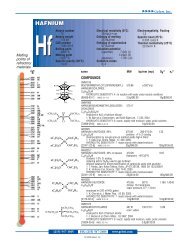Gelest Silicone Fluids - Gelest Inc.
Gelest Silicone Fluids - Gelest Inc.
Gelest Silicone Fluids - Gelest Inc.
Create successful ePaper yourself
Turn your PDF publications into a flip-book with our unique Google optimized e-Paper software.
▲<br />
▲<br />
▲<br />
▲<br />
<strong>Gelest</strong>, <strong>Inc</strong>.<br />
Rheological Behavior Under Shear<br />
At shear rates commonly encountered (≤10 4 s -1 ) polydimethylsiloxanes<br />
behave, at viscosities up to 1,000 cSt., like<br />
Newtonian fluids. Viscosity is constant and independent of the<br />
velocity gradient. Apparent viscosity is identical with viscosity<br />
extrapolated to zero velocity gradient.<br />
For oils of a higher viscosity than 1,000 cSt., this ratio is only<br />
constant for velocity gradients below a certain value. Beyond<br />
this value, becoming lower as the product becomes more viscous—the<br />
ratio is no longer constant: apparent viscosity falls<br />
below real viscosity (extrapolated for a zero velocity gradient)<br />
and the behavior is then known as “pseudoplastic.” This<br />
change is perfectly reversible, and behavior again becomes<br />
Newtonian when the velocity gradient falls once more below<br />
the critical value. Viscosity returns to its initial level even after<br />
intense shearing of long duration.<br />
As a guide, the table indicates the “critical” velocity gradients<br />
for polydimethylsiloxanes (where change of rheological<br />
behavior occurs) as well as apparent viscosity measured at<br />
velocity gradient equal to 10,000 s -1 .<br />
CH3<br />
CH3<br />
Si<br />
CH3<br />
O<br />
CH3<br />
Apparent<br />
viscosity<br />
for a velocity<br />
gradient<br />
Critical velocity of 10,000 s -1<br />
gradient (s -1 )<br />
(in cSt.)<br />
1,000 2,500 850<br />
12,500 200 4,700<br />
30,000 150 6,000<br />
100,000 30 8,200<br />
Si<br />
CH3<br />
O<br />
n<br />
CH3<br />
Si<br />
CH3<br />
CH3<br />
Apparent viscosity as a function of velocity gradient<br />
Viscosity in cSt.<br />
2,000,000<br />
1,500,000<br />
500,000<br />
200,000<br />
100,000<br />
50,000<br />
20,000<br />
10,000<br />
5,000<br />
2,000<br />
1,000<br />
2,500,000<br />
500,000<br />
200,000<br />
100,000<br />
60,000<br />
30,000<br />
20,000<br />
12,500<br />
10,000<br />
5,000<br />
2,000<br />
1,000<br />
500<br />
Temperature 25°C<br />
0.1<br />
0.2 0.3 1 2 5 10 20 50 100 200 500 1,000 2,000 5,000 20,000 100,000 500,000<br />
10,000 50,000 200,000 1,000,000<br />
VELOCITY GRADIENT (s -1 )<br />
(215) 547-1015 FAX: (215) 547-2484<br />
13


